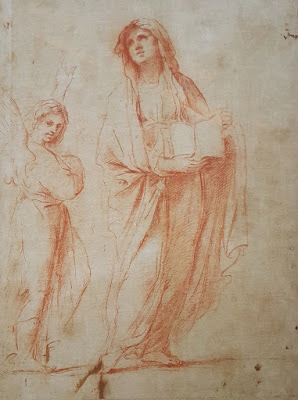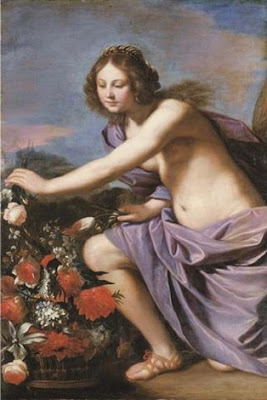 |
| Guercino (Giovanni Francesco Barbieri) St Andrew carrying the Cross 1656 oil on canvas private collection |
 |
| Guercino (Giovanni Francesco Barbieri) Immaculate Conception 1656 oil on canvas Pinacoteca Civica, Ancona |
 |
| Guercino (Giovanni Francesco Barbieri) Immaculate Conception 1656 drawing (figure study) Metropolitan Museum of Art, New York |
"[Guercino's Immaculate Conception] was not cited by [Carlo Cesare] Malvasia, but the account book documents the patron as Carlo Antonio Camerata (1620-87), a Bergamasque nobleman, whose agent, 'Sig. Carlo Manolesi' paid a deposit of 50 ducats (62 scudi, 2 lire) on 13 April 1656 and the balance of 80 ungari (237 scudi, 2 lire) on 28 August 1656. It remained in the possession of the descendants of the Conti Rocchi Camerata, until the death of Conte Luigi Rocchi Camerata (d. 1906), when it was left to the municipal collection."
 |
| Guercino (Giovanni Francesco Barbieri) The Entombment 1656 oil on canvas Art Institute of Chicago |
 |
| Guercino (Giovanni Francesco Barbieri) The Entombment 1656 drawing (figure studies - Mourning Virgin) private collection |
 |
| Pietro Fontana after Guercino The Entombment 1802 engraving British Museum |
 |
| Guercino (Giovanni Francesco Barbieri) St Francesca Romana 1656 oil on canvas Galleria Sabauda, Turin |
 |
| Guercino (Giovanni Francesco Barbieri) St Francesca Romana 1656 drawing (compositional study) Pinacoteca Civica, Cento |
"[The patron of St Francesca Romana was the] Olivetan monk, Pietro Marcellino Orafi (fl. 1640-57), a distinguished composer of sacred music, who became abbot of his order in 1652. According to a letter from Orafi, dated 5 February 1657, he gave the painting to 'Madame Reale', that is, Christine Marie of France (1606-63), Duchess of Savoy and regent of Charles Emmanuel II of Savoy. As often noted, the composition repeats, with variations, that of Guercino's earlier painting of the subject of 1638 in S. Maria in Oregano, Verona. The semicircular upper part of the canvas with two putti is a later addition."
 |
| Guercino (Giovanni Francesco Barbieri) St Anthony of Padua and the Infant Christ 1656 oil on canvas private collection |
 |
| Guercino (Giovanni Francesco Barbieri) St Anthony of Padua and the Infant Christ 1656 drawing (compositional study) Royal Library, Windsor |
 |
| Guercino (Giovanni Francesco Barbieri) Venus Crouching on the Ground (fragment of Mars, Venus, Cupid and Time) 1656-57 oil on canvas private collection |
"According to Malvasia, [the Mars, Venus, Cupid and Time (fragment above), and the Galatea (below) were conceived as pendants and] ordered by Ferdinand von Werdenberg as a gift for the Holy Roman Emperor, but they are not recorded in the Imperial collections. Since Ferdinand III died on 2 April 1657, it is possible the pictures may not have arrived in Vienna in time for their presentation to the Emperor, and so were perhaps retained by the patron."
 |
| Guercino (Giovanni Francesco Barbieri) Galatea 1656-57 oil on canvas Residenzgalerie, Salzburg |
 |
| Guercino (Giovanni Francesco Barbieri) Galatea 1656-57 drawing (compositional study) Morgan Library, New York |
 |
| Guercino (Giovanni Francesco Barbieri) Ecstasy of St Philip Neri 1656-57 oil on canvas Museo di Stato, Republic of San Marino |
 |
| Guercino (Giovanni Francesco Barbieri) Allegory of Painting and Drawing 1657 oil on canvas Gemäldegalerie, Dresden |
"According to Hans Posse, the Dresden painting was purchased in Paris in 1742, on behalf of Augustus III, Elector of Saxony, through his regular agent, Samuel de Brais."
– quoted texts from The Paintings of Guercino: a revised and expanded catalogue raisonné by Nicholas Turner (Rome: Ugo Bozzi Editore, 2017)